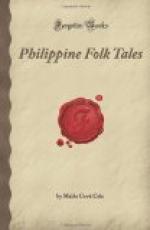[115] A somewhat similar belief that a giant crab is responsible for the tides is widespread throughout Malaysia. The Batak of Palawan now believe, as also do the Mandaya of eastern Mindanao, that the tides are caused by a giant crab going in and out of his hole in the sea.
[116] The similarity of this to the biblical story of the Flood leads us to suppose that it has come from the neighboring Christianized or Mohammedanized people and has been worked by the Bukidnon into the mould of their own thought. However, the flood story is sometimes found in such a guise that it cannot be accounted for by Christian influence. See for example, The Flood Story as told in the folk-lore of the Igorot tribe, on p. 102.
[117] This celestial myth accounts for a number of constellations which are of great importance to the Bukidnon. Magbangal appears in the sky in almost dipper shape, the handle being formed by his one remaining arm. To the west and nearly above him is a V-shaped constellation which is believed to be the jaw of one of the pigs which he killed. Still farther to the west appears the hill on which he hunted, while three groups of stars which toward dawn seem to be following him are said to be his hatchet, the bamboo pole in which he carried water, and his large pet lizard. It is the appearance and position of these constellations in the sky that show the Bukidnon when it is the time to clear land for the yearly crops and to plant the grain; and since this knowledge is of the utmost importance to the people, they feel that Magbangal does them a lasting service. The hero Lafaang of a Borneo myth, who is represented by the constellation Orion, lost his arm while trying to cut down a tree in a manner different from that prescribed by his celestial wife, the constellation Pegasen. See Hose and McDougall, Pagan Tribes of Borneo, Vol. II, p. 141.
[118] Long knives.
[119] Cloth is dyed in various colors by boiling it in water in which different kinds of leaves or roots have been steeped. But to produce a bluish-black shade the fabric is partly buried in mud until the desired color is obtained.
[120] Monkeys are numerous throughout the Philippines, and it is doubtless their human appearance and actions that have caused the different tribes to try to account for their origin from man. Here we have the most likely way that the Bukidnon can see for their coming.
[121] This is one of a series of tales dealing with mythical heroes of former times whose acts of prowess are still recounted by Bukidnon warriors.
[122] A heavy padded hemp coat with a kilt which is supposed to turn spears. Over the shoulder is worn a sash in which are a few peculiar stones and charms which are believed to protect its wearer. Warriors who have taken thirty human lives are permitted to wear a peculiar crown-shaped headdress with upstanding points.
[123] See note 1, p. 23.




